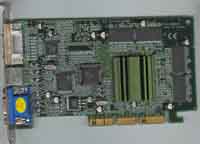The Card
The first thing Gainward did to differentiate their TNT2 from the rest of the market was to design a custom PCB. While the layout is basically like NVIDIA's reference design, they got rid of a lot of the extraneous unused space. That doesn't do a whole lot for performance or features, but what it does is allow Gainward to produce these guys at a lower cost, and that translates into savings for the consumer without sacrificing quality. Everything is still there though - TV out provided by the Brooktree BT869 and Digital Flat Panel (DFP) support by a SiI DFP controller. Both of these features are manufacturing options, so make sure you know what you're ordering.
The CARDEXpert TNT2 is based on the "standard" version of the TNT2 chipset, which according to NVIDIA, indicates that the core clock speed and the memory clock speed should be no less than 125MHz and 150MHz respectively. However, NVIDIA has left the exact clock speeds up to the manufacturers and many have chosen to ship at higher than these recommended clock speeds.
Our review sample featured 32MB of SDRAM in the form of four 7ns 8MB Samsung chips on the front of the board. As we noted in AnandTech's July '99 RIVA TNT2 Roundup, 7ns SDRAM is actually officially rated to only run at 143 MHz, but that most manufacturer's felt confident in running them at 150 MHz to meet the NVIDIA recommended memory clock speed. The Gainward engineers, however, decided to play things by the book and the default memory clocking here is 143 MHz. Just like with the Gigabyte GA-660 that used the same Samsung 7ns SDRAM, we were able to reliably overclock the memory to 160 MHz.
The TNT2 core is cooled by Gainward's unique semicircular heatsink that does a good job of cooling the core. It's attached by thermal tape, which isn't as efficient as heatsink compound when applied properly, but is much better than improperly applied heatsink compound. Since we've seen a number of video card heatsinks with improperly applied heatsink compound, maybe some manufacturers that are in a big rush should check out the thermal tape method. With this cooling in place, we were able to obtain overclocked speeds of 150 MHz - the default for a TNT2 Ultra, but somewhat below that obtained by other TNT2's. However, those other cards also featured active cooling, which most likely made the difference.
The 2D image quality of the CARDEXpert TNT2 follows the pattern of other TNT2's out there - it is fine at resolutions up to 1280 x 1024, but at 1600 x 1200 the image quality takes a noticeable dive. Although it is noticeably better than the best TNT cards in terms of 2D image quality most TNT2 based cards, aren't too friendly on your eyes at 1600 x 1200 and above. If you're really looking for a combination of a professional/gaming card then Matrox's G400/G400MAX is probably what you should be setting your sights on, unfortunately getting one of those hot items is easier said than done.












0 Comments
View All Comments